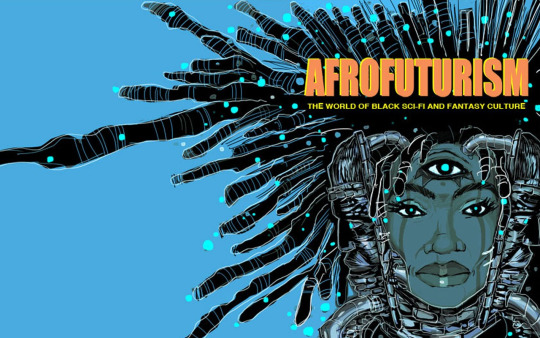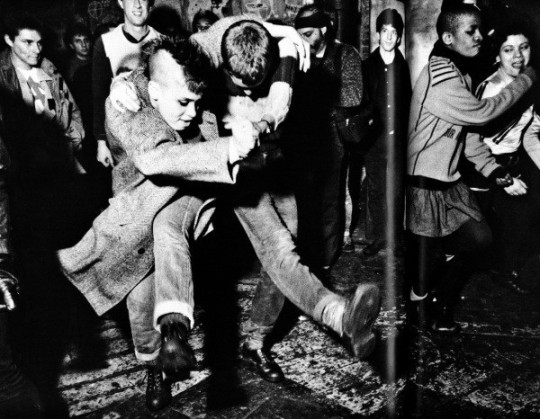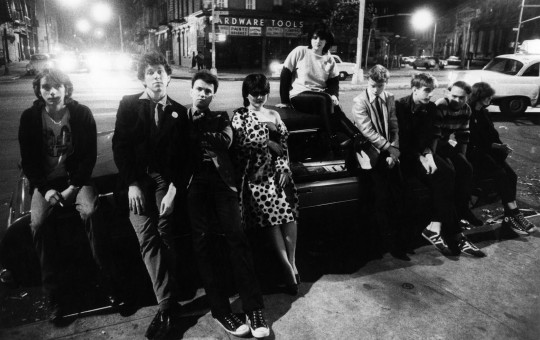Blog for "Steampunk" the DocumentaryComing out 2025 (No AI)
Don't wanna be here? Send us removal request.
Text
Crafting A Fantasy Culture, or the fallacies of using culture in the singular
The world is an interdependent place.
A lot of Western writers will look at the need to diversify their writing and try to cherry pick outside cultures to add. They then come to us with a laundry list of questions about what they’re allowed to change about those cultures because, well, they didn’t pull from a broad enough context.
The thing about researching individual cultures is: you’re never going to be researching just one culture. You’re going to be researching all the cultures they interacted with, as well.
Cultures are made by interacting with other cultures. So you can’t simply plop a singular culture into a fantasy world and expect it to work. There is too much outside influence on that culture for you to get a holistic picture by researching the culture in isolation.
Instead, you need to ask yourself, “what environments made them, and how much of their surrounding contexts do I need to add to my fantasy world to make this genuine respectful representation?”
And before you say that you can’t possibly do that, that is too much research, let me introduce you to the place you’re already doing it but don’t realize:
Stock Fantasy World 29
Aka, fantasy Europe.
It gets ragged on a lot, but let’s take a minute to look at the tropes that build this stock fantasy world.
Snow
4 seasons
Boars, pigs, wolves, dogs, pine trees, stone
Castles
Sheep
Knights
A king
Farming based economy
Religion plays a pretty big role in life
All fairly generic fantasy Europe tropes. But if you look more closely, you’ll notice that this is painting a picture of Fantasy Germany/the Netherlands, with perhaps a dash of France and/or England in there, all of it vaguely Americanized (specifically the New England area) because there’s usually potatoes and tomatoes. The geographic region is pretty tight, and it just so happens to mesh with the top three superpowers of upper North America, and arguably the English speaking world.
But let’s keep going.
They import stuff. Like fine cloth, especially silk, along with dyes & pigments
These things are expensive from being imported, so the nobility mostly have them
There’s usually a war-mongering Northern People invading places
If brown people exist they are usually to the East
There might be a roaming band of nomadic invaders who keep threatening things
There is, notably, almost no tropical weather, and that is always to the South if it’s mentioned
There might be an ocean in the South that leads to a forgien land of robed people to survive a desert (or did I just read too much Tamora Pierce?)
And, whoops, we have just accidentally recreated European history in its full context.
The Northern people are Norse, and their warring ways are indicative of the Viking Invasion. The imports hint at Asia, namely the Ottomans and India, and the silk road. The roaming invaders are for Mongolian Khanate. The ocean and tropical weather in the South hints at Spain, Greece, and the Mediterranean. And the continent of robed people indicates North Africa, and/or Southwest Asia.
Suddenly, stock fantasy world 29 has managed to broad-strokes paint multiple thousands of years of cultural exchange, trade, wars, invasions, and general history into a very small handful of cultural artifacts that make up throwaway lines.
Europe As Mythology And You
European history is what’s taught in Western classrooms. And a lot of European history is painted as Europe being a cultural hub, because other places in the world just aren’t talked about in detail—or with any sort of context. Greece and Rome were whitewashed; the Persian and Ottoman empires were demonized; North Africans became the enemy because of their invasion of Spain and the fact many of them were not-Christian; the Mongolian Khanate was a terrible, bloodthirsty culture whose only goal was destruction.
But because all of these parts did interact with Europe and were taught in history class, writers crafting a fantasy Europe will automatically pull from this history on a conscious or subconscious level because “it’s what makes sense.”
The thing is, despite people writing European fantasy subconsciously recreating European history, they don’t actually recreate historical reality. They recreate the flattened, politically-driven, European-supremacist propaganda that treats every culture outside of Europe as an extra in a movie that simply exists to support Europe “history” that gets taught in schools.
As a result of incomplete education, a lot of people walk away from history class and believe that cultures can be created in a vacuum. Because that’s the way Europe’s history was taught to them.
Which leads to: the problem with Fantasy World 29 isn’t “it’s Europe.” It’s the fact it’s an ahistorical figment of a deeply colonial imagination that is trying to justify its own existence. It’s homogeneous, it only mentions the broader cultural context as a footnote, it absolutely does not talk about any people of colour, and there’s next to no detailing of the variety of people who actually made up Europe.
So writers build their Fantasy World 29 but they neglect the diversity of religion and skin tone and culture because it’s unfamiliar to them, and it was never taught to them as a possibility for history.
While “globalization” is a buzzword people throw around a lot to describe the modern age, society has been global for a large portion of human history. There were Japanese people in Spain in the 1600s. Polynesians made it to North America decades if not centuries before Columbus did. There are hundreds more examples like this.
You can absolutely use fantasy to richen your understanding of Europe, instead of perpetuating the narratives that were passed down from victor’s history. People of colour have always existed in Europe, no matter what time period you’re looking at, and unlearning white supremacist ideas about Europe is its own kind of diversity revolution.
Travel is Old and People Did It Plenty
Multiculturalism is a tale as old as time. And while some populations were very assimilationist in their rhetoric, others were very much not. They would expand borders and respect the pre-existing populations, or they would open up networks to outsiders to become hubs of all the best the world had to offer. Even without conscious effort, any given place was building off of centuries of human migration because humans covered the globe by wandering around, and people have always been people.
Regardless, any time you have a group of people actively maintaining an area, they want to make travelling for themselves easier. And the thing about making travelling for yourself easier is: it made travel for outsiders just as possible. By the time you reach the 1200s, even, road, river, and ocean trade networks were thriving.
Sure, you might be gone for a year or three or five because the methods were slow, but you would travel. Pilgrimages, trade routes, and bureaucratic administrative routes made it possible for people to move around.
And also, soldiers and war did really good jobs of moving people around, and not all of them went back “home.” Hence why there have been African people in England since the Roman empire. When you have an empire, you are going to take soldiers from all over that empire; you aren’t going to necessarily pull from just the geographic region immediately surrounding the capital.
Yes, the population that could travel was smaller than it is now, because land needed to be worked. But Europe isn’t the be all end all in how much of its population needed to be in agriculture in order to function; the Mughals, for example, had 80% of their population farming, compared to over 90% for Europe in the same time period. That’s an extra 10% of people who were more socially free to move around, away from their land. Different cultures had different percentages of people able to travel.
This isn’t counting nomadic populations that relied on pastoralism and horticulture who didn’t actually settle down, something a lot of history tends to ignore because cities are easier to discuss. But nomadic populations existed en masse across Eurasia, and they took cultural traditions all over the continent.
Just because it wasn’t fast doesn’t mean it didn’t happen. And just because a lot of Europeans couldn’t travel because of the agricultural demands of the continent, doesn’t mean every other culture was as tied to settlements.
Multiculturalism and Diffusion
While each individual culture is unique, and you can find pockets of difference anywhere, cultures exist on a sliding scale of broad customs across the globe. Greece and Turkey will have more in common than China and England, because the trade routes were much closer and they shared central rulership for multiple hundreds of years.
This is why we keep saying it’s important to keep cultures with other cultures close to them. Because those are the natural clusters of how all of the cultures involved would be formed. The proper term for this is cultural diffusion, and it happened all the time. Yes, you could get lots of people who had their own unique customs to set themselves apart. But they had the same natural resources as the dominant group, which meant they couldn’t be completely and totally alien.
Even trade influence wouldn’t produce the same results in two places. When Rome imported silks from China, they rewove them to be a different type of fabric that was lighter and more suited to their climate. Then the Romans sold the rewoven silk back to China, who treated it differently because they’d woven it the first way for a reason. They didn’t talk to each other directly because of how the Silk Road was set up at the time, either, so all they had were the goods.
And people automatically, subconsciously realize this whenever they write Fantasy World 29. They put like cultures with like cultures in Europe. Because even if they weren’t really taught to see the rest of the world as anything more than a footnote, they still transfer those footnotes to their fantasy.
The problem is, people don’t realize the gradient of customs. In the modern day, Greece and Turkey are different countries, with histories that are taught in totally different frameworks (Greece as an appropriated white supremacist “ancient land” that all Western European societies are descendent from, Turkey as a land of brown people that were Muslim and therefore against the Good Christian Europe), so it’s really easy to ignore all of their shared history.
People often fought for the right to rule (or even exist) in a place, which deeply impacted the everyday people and government. Ancient Persia is a fantastic example of this, because it covered huge swaths of land and was a genuinely respectful country (it took over a deeply disrespectful country); had it not been for Cyrus the Great deciding that he would respect multiculturalism, the Second Temple wouldn’t have been rebuilt in Jerusalem.
You can’t homogenize an area that was never homogenous to begin with. Because there was a ton of fighting and sometimes centuries-old efforts to preserve culture in the face of all this fighting (that sometimes came with assimilation pressure). Dominant groups, invading groups, influencing groups, and marginalized groups have always existed in any given population. See: Travel is Old above. See: people have always been people and wandered around. Xenophobia is far, far older than racism ever will be, because xenophobia is simply “dislike of Other” and humans love crafting “us vs them” dynamics.
This lack of unity matters. It’s what allows you to look at a society (especially one with a centralized government) and see that it is made up of people that are different. It leads you to asking questions such as:
Who was persecuted by this group?
Did the disliked group of people exist within their borders, or were they driven away and are now enemy #1?
What was their mindset on diversity?
How did they handle others encroaching on what they saw as their territory?
People do different things across different households, let alone hundreds of miles away. You wouldn’t expect someone from a rich, white area of California to behave the same way as someone from a middle-class immigrant neighbourhood from NYC. I’m sure, if you looked at your own city, you would scoff at the concept of someone mistaking your city for one five hours away, because when you know them, they’re so different.
So why do you expect there to be only one type of person anywhere else?
Cultural and Geographic Context Matters
A region’s overreacting culture (either determined by groups of people who mostly roam the land, or a centralized government) and their marginalized cultures determine the infighting within a group, even if the borders remain the same.
Persecution and discrimination are just as contextual as culture. Even if the end result of assimilation and colonialism was the same, the expectations for assimilation would look different, and what they had been working with before would also look different. You can’t compare Jewish exile from various places in Europe with Rromani exiles in Europe, and you definitely can’t compare them with the Hmong in Southeast Asia. They came from different places and were shaped by different cultures.
A culture that came from a society that hated one particular aspect of them will not form—at all—if they’re placed in a dominant culture that doesn’t find their cultural norms all that persecution-worthy. And the way they were forced to assimilate to survive will play into whatever time period you’re dealing with, as well; see the divide of Jewish people into multiple categories, all shaped by the resources available in the cultures they stayed in the longest.
You can’t remove a culture’s context and expect to get the same result. Even in a culture that doesn’t wholesale have an assimilationist agenda, you can still get specific prejudices and scapegoats that happen when there’s a historical precedent in the region for disliking a certain group.
Once you start cherry picking what elements of a culture to take—because you’ve plunked the !Kung into Greece and need to modify their customs from the desert to a tropical destination —you’re going to end up with coding that is absolutely positively not going to land.
Coding is a complex combination of foods, clothing, behaviour/mannerisms, homes, beliefs, and sometimes skin tone and facial features. A properly coded culture shouldn’t really need any physical description of the people involved in order to register as that culture. So when you remove the source of food, clothing, and home-building materials… how can you code something accurately from that?
And yes, it’s intimidating to think of doing so much research and starting from 0. You have to code a much larger culture than you’d originally intended, and it absolutely increases the amount of work you have to do.
But, as I said, you are already doing this with Europe. You’re just so familiar with it, you don’t realize. You can get a rundown of how to code the overarching culture with my guide: Representing PoC in Fantasy When Their Country/Continent Doesn’t Exist
Takeaways
Writers need to be aware of diversity not just as a nebulous concept, but as something that simply exists and has always existed. And the diversity (or lack thereof) of any one region is a result of, specifically, the politics of that region.
Diversity didn’t just exist “over there”. It has always existed within a society. Any society. All societies. If you want to start adding diversity into your fantasy, you should start looking at the edges of Fantasy World 29 and realize that the brown people aren’t just stopping at the designated border and trading goods at exactly that spot, but have been travelling to the heart of the place for probably a few hundred years and quite a few of them probably liked the weather, or politics, better so they’ve settled.
Each society will produce a unique history of oppressing The Other, and you can’t just grab random group A and put it in societal context B and expect them to look the same. Just look at the difference between the Ainu people, the anti-Indigenous discrimination they face, and compare it to how the Maori are treated in New Zealand and the history of colonialism there. Both Indigenous peoples in colonial societies on islands, totally different contexts, totally different results.
If random group A is a group marked by oppression, then it absolutely needs to stay in its same societal context to be respectful. If random group A is, however, either not marked by being oppressed within its societal context and/or is a group that has historically made that move so you can see how their situation changed with that move, then it is a much safer group to use for your diversity.
Re-learn European history from a diverse lens to see how Europe interacted with Africa and Asia to stop making the not-Europe parts of Fantasy World 29 just be bit parts that add flavour text but instead vibrant parts of the community.
Stop picking singular cultures just because they fascinate you, and place them in their contexts so you can be respectful.
~ Mod Lesya
7K notes
·
View notes
Text

Data scientist and co-founder of Geosoft Global Innovation, Ugochukwu Charles Akajiaku from Nigeria on solarpunk climate change mitigation.
As someone who grew up in the Niger Delta region of Nigeria, he witnessed firsthand the impact of environmental degradation, flooding, and poor infrastructural development on the side of the government and the oil companies in the region.
He added that his big break came when he combined his passion for geospatial data with machine learning to build a flood-prediction model for communities along River Niger.
“The model used satellite imagery, weather data, and elevation models to forecast high-risk areas before disasters hit. That project helped to cut down emergency response time and made local planning more proactive,” he said.
“Climate change is personal for me. It is happening in my hometown, to my people. That is why I build,”
171 notes
·
View notes
Text
Diane and Peter's Wedding in Locus
I should have posted this sooner and I'm sorry that I didn't. With the unfortunate news about the passing of Peter Morwood, I feel it's best to finally share this. The wedding of Diane Duane and Peter Morwood was announced on the cover of the April 1987 edition of Locus magazine, where the term 'Steampunk' was first coined. @dduane I hope you know how much I've enjoyed holding onto this in light of how much I have appreciated the work of you and your husband. I'm so sorry for your loss.


#diane duane#peter morwood#locus magazine#sci fi and fantasy#science fiction#steampunk#fantasy literature
1K notes
·
View notes
Text
me: if I become the evil overlord I will never harm my minions
[5 years later]
highly throwable imp: hoohoohee
me: hmm
202K notes
·
View notes
Text
Afro-Futurist Reading List Vol 2.
Afro Futurism Reading List Vol 1:
Afro Futurism Reading List Vol 2:

Black Speculative Fiction Breakdown by Genre
African Fantasy (early myths and fables from the continent): Forest Of A Thousand Deamons: A Hunter’s Saga by Daniel O. Fagunwa The Palm Wine Drinkard by Amos Tutuola My Life In The Bush Of Ghosts by Amos Tutuola Simbi and the Satyr of the Dark Jungle by Amos Tutuola The Brave African Huntress by Amos Tutuola Feather Woman of the Jungle by Amos Tutuola Ajaiyi and his Inherited Poverty by Amos Tutuola The Witch-Herbalist of the Remote Town by Amos Tutuola
Utopia (alternate histories written during the jim crow & antebellum eras): Blake Or The Huts Of Africa by Martin Delany Imperium In Imperio by Sutton E Griggs Light Ahead For The Negro Edward A Johnson One One Blood by Pauline Hopkins Black No More by George Shuyler Lord Of The Sea by MP Sheil
Space Opera (far future sci fi worlds of interplanetary travel): Nova by Samuel R Delany Stars In My Pocket Like Grains Of Sand by Samuel R. Delany Binti Trilogy by Nnedi Okorafor An Unkindness Of Ghosts by Rivers Solomon Midnight Robber by Nalo Hopkinson Rayla 2122 Series by Ytasha Womack Trouble On Triton by Samuel R. Delany Babel 17 by Samuel R Delany Empire Star by Samuel R Delany The Galaxy Game by Karen Lord The Best Of All Possible Worlds by Karen Lord Ancient Ancient by Klini Iburu Salaam Escaping Exodus by Nicky Drayden Ascension: Tangled Axon by Jacqueline Koyanagi Teleportality by T Cisco Nadine’s Bible Seris by T Lindsey-Billingsley Nigerians In Space Series by Deji Bryce Olukotun
Aliens (alien encounters): Lilith’s Brood Trilogy by Octavia Butler Lagoon by Nnedi Okorafor Rosewater Trilogy by Tade Thompson The Lesson by Cadwell Turnbell The Wave by Walter Mosley
Dystopia (oppressive futures and realities): Friday Black by Nana Kwame Adjie Brenyah Riot Baby by Tochi Onyebuchi War Girls Series by Tochi Onyebuchi Sunshine Patriots by Bill Campbell Gunmen’s Peace by Milton J Davis Dragon Variation by T Cisco
Experimental (literary tricksters): The Ravicka Series by Renee Gladman The Freedom Artist by Ben Okri The Structure Of Dante’s Hells by LeRoi Jones The House Of Hunger by Dumbudzo Marachera Black Sunlight By Dumbudzo Marachera Yellow Back Radio Broke Down by Ishmaeel Reed The Last Days Of Louisiana Red by Ishmaeel Reed The Sellout by Paul Beatty Koontown Killing Kaper by Bill Campbell The African Origin Of UFOs by Anthony Joseph Quantum Black Futurism(Theory & Practice Volume 1) by Rasheeda Philips by Rasheeda Philips Spacetime Collapse: From The Congo to Carolinas Spacetime Collapse II: Community Futurisms by Rasheeda Philips consent not to be a single being trilogy by Fred Mot
Post-Apocalyptic (worlds falling apart): The Purple Cloud by MP Shiel Dhalgren by Samuel R Delany The Parable Series by Octavia Butler Brown Girl In The Ring by Nalo Hopkinson
Dying Earth (far future post-apocalyptic worlds + magic):
The Broken Earth Trilogy by NK Jemisin The Einstien Intersection by Samuel R. Delany The Jewels Of Aptor by Samuel R. Delany The Fall Of The Towers Trilogy by Samuel R. Delany Who Fears Death by Nnedi Okorofor The Book Of Phoenix by Nnededi Okorofor The Prey Of Gods by Nicky Drayden
Alternate History (alternate timelines and what-ifs): Mumbo Jumbo by Ishmael Reed Everfair by Nisi Shawl The Underground Railroad by Colson Whitehead The Water Dancer by Ta-Nehisi Coates The Insh'Allah Series by Steven Barnes Ring Shout by P Djelia Clark A Dead Djinn In Cairo by P Djelia Clark The Black God’s Drum by P Djelia Clark Washington Black by Esi Edugyan Pimp My Airship: A Naptown By Airship Story by Maurice Beaudice The Dream Of Perpetual Motion by Dexter Palmer Pym by Matt Johnson, Dread Nation Series by Justina Ireland From Here to Timbuktu by Milton J Davis
High Fantasy (magical kindoms and high adventures): The Neveryorn Series by Samuel R. Delany Black Leapard Red Wolf by Marlon James The Deep by Rivers Solomon & Clipping Imaro Series by Charles R. Saunders The Children Of Blood & Bone by Tomi Adeyemi The Children Of Virtue & Vengeance by Tomi Adeyemi The Sorcerer Of The Wildeeps by Kai Ashai Washington A Taste Of Honey by Kai Ashai Washington Beasts Made Of Night Series by Tochi Onyebuchi A Place Of Nights: War & Ressurection by Oloye Karade, Woman Of The Woods: A Sword & Soul Epic by Milton J Davis Temper by Nicky Drayden They Fly At Ciron by Samuel R. Delany Anansi Boys by Neil Gaiman The House Of Discarded Dreams by Etakterina Sedia
Magic Realism (literary naturalism with surreal, dreamlike, and mythic imagery): The Echo Tree & Other Stories by Henry Dumas The Kingdom Of This World by Alejo Carpentier General Sun My Brother by Jacques Stephen Alexis The Famished Road Series by Ben Okri The New Moon’s Arms by Nalo Hopkinson The Salt Roads by Nalo Hopkinson Montaro Caine by Sydney Portier Mama Day by Gloria Naylor Redemption In Indigo by Karen Lord Mem by Bethany C Morrow
Urban Fantasy (modern citybound fantasy): The City We Became by NK Jemisin Sister Mine by Nalo Hopkinson The Chaos by Nalo Hopkinson The Intuitionist by Colson Whitehead Blue Light By Walter Mosley Fire Baptized by Kenya Wright
Time Travel (stories unstuck in time): Kindred by Octavia Butler Version Control by Dexter Palmer Recurrence Plot by Rasheedah Phillips
Horror (nightmare, terrors, and hauntings): Beloved by Toni Morisson African Immortals by Tananarivue Due Fledgling by Octavia Butler The Gilda Stories by Jewelle Gomez Lakewood by Meggan Giddings The Ballad Of Black Tom by Victor Lavalle Lovecraft Country by Matt Ruff The Changeling by Victor Lavealle Zone One by Colson Whitehead The Between by Tananarive Due The Good House by Tananarive Due Ghost Summers: Stories by Tananarive Due Unhollowed Graves by Nunzo Onho Catfish Lullaby by AC Wise
Young Adult (books for young adults): Akata Witch Series by Nnedi Okorofor Zarah The Windseeker & The Shadow Speaker by Nnedi Okorofor Long Juju Man by Nnedi Okorofor Ikenga by Nnedi Okorofor Tristan Strong Series by Kwame Mbalia A Song Below Water by Bethany C Morrow Daughters Of Nri by Reni K. Amayo A River Of Royal Blood by Amanda Joy 47 by Walter Mosley
Comics (graphic storytelling) George Herriman Library: Krazy & Ignatz (1919-1921) by George Herriman The Boondocks Complete Collection by Aaron Mcgruder Birth Of A Nation by Aaron Mcgrudger, Reginald Hudlin, & Kyle Baker Prince Of Cats by Ronald Wimberly Concrete Park by Erika Alexander & Tony Puryear Incognegro Series by Matt Johnson Your Black Friend & Other Stories by Ben Passmore Bttm Fdrs Ezra Clayton Daniels & Ben Passmore Sports Is Hell is Ben Passmore LaGuardia by Nnedi Okorofor & Tana Ford Bread & Wine: An Erotic Tale Of New York by Samuel R Delany & Mia Wolff Empire by Samuel R Delany & Howard Chaykin Excellence by Brandon Thomas Bitteroot by David F Walker, Chuck Brown & Sanford Greene Black by Kwanza Osajyefo Niobe: She Is Life by Amandla Stenberg & Sebastian A Jones Black Panther by Christopher Priest Black Panther by Reginald Hudlin Black Panther by Ta-Nehisi Coates Shuri by Nnedi Okorofor World Of Wakanda by Roxane Gay Truth: Red, White, & Black by Kyle Baker House Of Whispers by Nalo Hopkinson & Neil Gaiman Naomi by David F Walker, Brian Micheal Bendis, & Jamal Campbell Far Sector by NK Jemison & Jamal Campbell
Short Stories (collections by single authors): Driftglass by Samuel R Delany, Distant Stars by Samuel R Delany Bloodchild & Other Stories by Octavia Butler Unexpected Stories by Octavia Butler Falling In Love With Hominids by Nalo Hopkinson Skin Folk by Nalo Hopkinson, Kabu Kabu by Nnedi Okorofor, How Long Til Black Future Month? by NK Jemisin Nine Bar Blues by Sheree Reneee Thomas
Anthologies (collections from multiple authors) Dark Matter edited by Sheree Renee Thomas So Long Been Dreaming edited by Nalo Hopkinson Conjure Stories edited by Nalo Hopkinso Whispers From The Cotton Tree Root: Caribbean Fabulist Fiction edited by Nalo Hopkinson Afro SF: Science Fiction by African Writers edited by Wor. W. Hartmaan Stories For Chip: A Tribute To Samuel R Delany edited by Nisi Shawl Octavia’s Brood: Science Fiction Stories From Social Justice Movement edited by Adrienne Marie Brown & Walidah Imarisha Mothership: Tales of Afrofuturism and Beyond edited by Bill Campbell The City: Cyberfunk Antholoy edited by Milton J Davis Steamfunk edited by Milton J Davis Dieselfunk edited by Milton J Davis Griots: A Sword & Soul Anthology by Milton J Davis & Charles R Saunders Griots: Sisters Of The Spear by Milton J Davis & Charles R Saunders
Non-Fiction (histories, essays, and arguments) Afrofuturism And The World Of Black Sci-Fi & Fantasy Culture by Ytasha Womack Afrofuturism 2.0: The Rise Of Astral Blackness edited by Reynaldo Anderson & Charles E Jones The Black Imagination: Science Fiction, The Future, and The Speculative by Sandra Jackson & Julie E Woody-Freeman Afro-Futures & Astral Black Travel by Juice Aleem The Sound Of Culture: Diaspora & Black Technopoetics by Louis Cude Soke Black Utopia: The History Of An Idea From Black Nationalism To Afrofuturism by Alex Zamalin Afrouturism Rising: The Literary Pre-History Of A Movement by Isiah Lavendar III A Pure Solar World: Sun Ra & The Birth Of Afrofuturism by Paul Youngquist Where No Black Woman Has Gone Before: Subversive Poryrals In Speculative Film & TV by Diana Adesola Mafe Black Kirby: In Search Of The Motherbox Connection by John Jennings & Stacey Robinson Super Black: American Pop Culture & Black Super-Heroes by Adilifu Nama Black Space: Imagining Race In Science Fiction Film by Adilifu Nama Black Super-Heroes, Milestone Comics, And Their Fans by Jeffery A Brown Emergent Strategy: Shaping Change, Changin Worlds by Adrienne Marie Brown
*cover image from Ytasha Womack’s “Afrofuturism: The World Of Black Sci-Fi & Fantasy Culture”
(please post anything I might have left out in the comments)
426 notes
·
View notes
Text
Finished !
Aetherwings + Aethecore by Mecrobremake
It took SOME (too many) hoirs to complète but I love it !


#tkluts#20000 leagues under the sea#jules verne#steampunk#machinery#leonardo da vinci#vernian#clockpunk
161 notes
·
View notes
Text
You have no idea how excited I got when I realized he scored as many things has he has bc his music is also all over my upcoming documentary (along with several other artists including Nathaniel Johnstone of Abney Park, Lisa Hammer, and Chris Johnson).
there should be a tax that youtubers pay where 1.5% of all of their revenue goes back to Kevin Macleod for basically supplying YouTube with it’s own soundtrack.
203K notes
·
View notes
Text

Salma Hayek, Wild Wild West, 1999
148 notes
·
View notes
Text
There's a difference between "disabled" and "legally recognized as disabled," and I just want to give a shout-out to all the other disabled people who don't have formal diagnoses, who don't have access to benefits of any kind, who don't have the ability to use even the shittiest and least-helpful resources, because the process of getting legal recognition for disability sucks ass.
And another shout-out to all the disabled people who purposely avoid getting diagnosed, because official diagnoses can be used against you, and you're unable or unwilling to risk it.
44K notes
·
View notes
Text
The clean-yet-practical vibe of 1970s sci-fi.
The transition era between Raygun Gothic and Used Future/Cassette Futurism.







966 notes
·
View notes
Text
bro i LOVE indigenous fusion music i love it when indigenous people take traditional practices and language and apply them in new cool ways i love the slow decay and decolonisation of the modern music industry
57K notes
·
View notes
Photo








SP. 101 - The Fifth Element (1997)
Cyberpunk Apartment.
7K notes
·
View notes
Text

Arkivestery, designed by Karen Fleisch
#steampunk#y2k aesthetic#goth aesthetic#00s fashion#00s style#arkivestry#goth fashion#retro fashion#coquette#simplicity patterns#sewing patterns#doll aesthetic#sci fi and fantasy#victorian gothic
1 note
·
View note
Text
"I like things that show the means in which they were made, I'm very process oriented. So, the Crucible is all about that process. It was also very much, and still is, about giving people access to the industrial means of production... Instead of y'know, instead of just working with clay or something. And being able to do, you know metalcasting, machining or foraging." - Maker Michael Sturtz, excerpt from the upcoming "Steampunk" the documentary series.
#steampunk#marxism#michael sturtz#steampunks#punk#steampunk documentary#documentary#independent film
0 notes


















